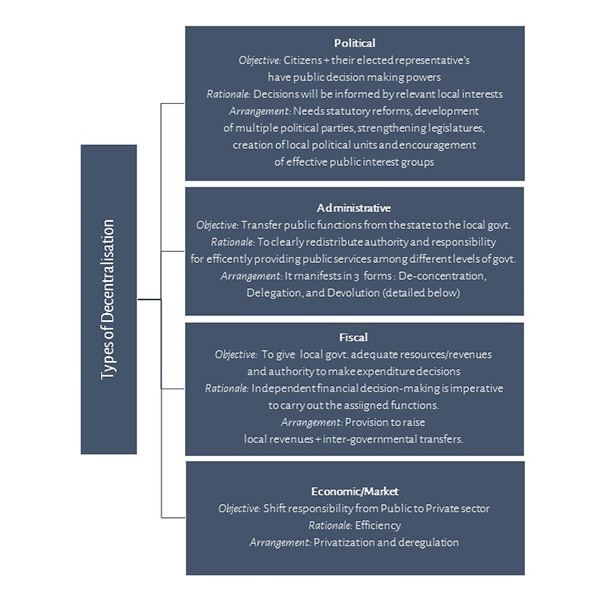
Decentralisation for Dummies
27 September 2016
We come across the word ‘decentralisation’ in varied contexts. One place it is commonly used is in governance related literature. In spite of its extensive usage among professionals in the development sector, it is a little understood term. Plus, the literature on this subject is relatively new and continuously evolving. Therefore, we decided to explore this term and its many nuances through a blog series.
What is decentralisation?
Simply put, decentralisation is the transfer of authority and responsibility from the Central government to regional and local authorities.
The United Nations Development Programme (UNDP) has laid out the topic of decentralisation through a systems approach including levels, spheres, sectors and functions. Here they consider the community level as the focal point to determine where the goals of the citizens emerge and where it can be best supported.
There are 4 broad types of decentralisation – political, administrative (de-concentration, delegation and devolution), fiscal and economic. While there is considerable overlap between them it is not essential that all four forms exist in a country which chooses to decentralise.
For instance, state governments in East Asian countries decentralised administratively and fiscally but not politically.

Administrative decentralisation – a critical form that actually redistributes functions and authorities from state to local governments can manifest (as mentioned above) in the following ways:
- De-concentration: It is the transfer of decision making authority from a sectoral department at the state to its field offices. De-concentration can take place in 2 forms-
- The budget of the field office and its staff comes from the sector department of the state or
- The sector staff in the field office is entrusted with the role of representing the state and also plays an important role in the local governments.
Example: In Myanmar, business registration is managed by the Ministry of Commerce which established outreach offices at the local level for company registration to issue documents on behalf of the ministry.
De-concentration can capture significant advantages ascribed to decentralisation like speedy decision making and responsiveness to local needs. But it does not deliver on local participation, democratic decision making and accountability.
- Delegation: Is the transfer of decision making authority from the state to the local government a special purpose body or even to a non-public sector entity.
Example: In Nepal, the state government can delegate certain tasks like payment of social security allowances up to the village level through the district development committees.
- Devolution: The most comprehensive form of decentralisation, it requires political, fiscal and administrative measures. It also involves empowering locally elected political bodies which represent the citizens Vis a Vis the local administration and the state.
Example: In Indonesia, the Big Bang decentralisation was based on devolution where the local government had complete fiscal and managerial responsibilities over service functions such as education and health care.

Padmapriya Janakiraman leads Accountability Initiative’s research in the areas of Panchayat finance and decentralisation. She also works with the public finance team on budget analysis and fund flow tracking.
Prerananandita Baisnab works in the Public Finance team with a primary focus on budgetary analysis of the Union and the States and tracking fund flows of different centrally sponsored schemes on health, sanitation and education.





